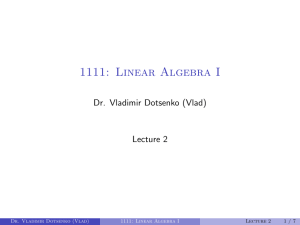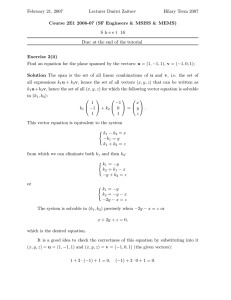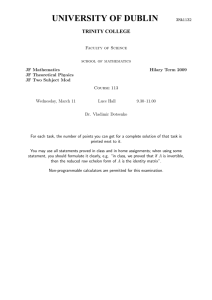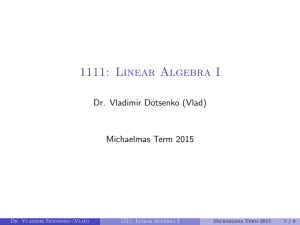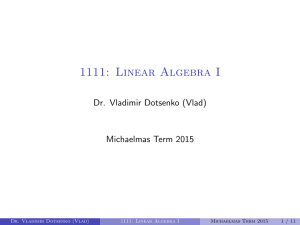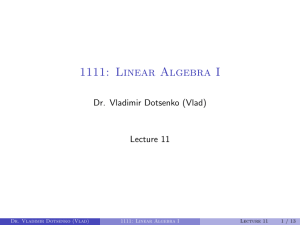1111: Linear Algebra I Dr. Vladimir Dotsenko (Vlad) Lecture 3 1 / 11
advertisement
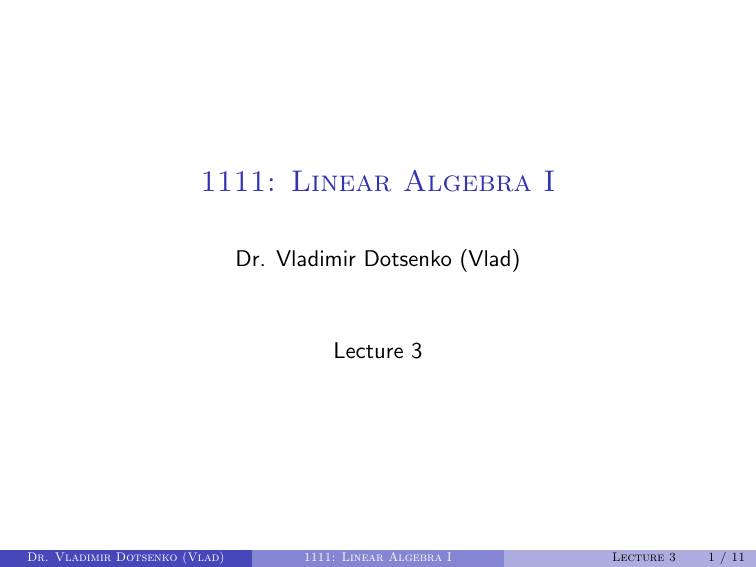
1111: Linear Algebra I Dr. Vladimir Dotsenko (Vlad) Lecture 3 Dr. Vladimir Dotsenko (Vlad) 1111: Linear Algebra I Lecture 3 1 / 11 Properties of vector product Last time, we stopped just short of proving the theorem on properties of scalar and vector products. The statement that was still left to prove was u × (v × w) = (u · w)v − (u · v)w. Dr. Vladimir Dotsenko (Vlad) 1111: Linear Algebra I Lecture 3 2 / 11 (Multi)linearity Recall that we already know the following: for the given (scalar or vector) product of two vectors v and w, if replace one of the vectors, say w by a sum of two vectors, say w = w1 + w2 , then the result is the same as when you first compute the products with individual summands and then add the results. The same holds for re-scaling: if in a product you multiply one of the vectors by a number, the result is the same as when you compute the product and then multiply the result by that number. This long paragraph just means that (u1 + u2 ) · v = u1 · v + u2 · v, u · (v1 + v2 ) = u · v1 + u · v2 , (cu) · v = u · (cv) = c(u · v), (u1 + u2 ) × v = u1 × v + u2 × v, u × (v1 + v2 ) = u × v1 + u × v2 , (cu) × v = u × (cv) = c(u × v). Dr. Vladimir Dotsenko (Vlad) 1111: Linear Algebra I Lecture 3 3 / 11 (Multi)linearity In general, a function f of several vectors u, v, . . . is said to be linear in all its arguments (or multilinear) if f (u1 + u2 , v, . . .) = f (u1 , v, . . .) + f (u2 , v, . . .), f (cu, v, . . .) = cf (u, v, . . .), f (u, v1 + v2 , . . .) = f (u, v1 , . . .) + f (u, v2 , . . .), f (u, cv, . . .) = cf (u, v, . . .), ... Using dot and cross products, it is easy to build many multilinear functions; for example, u, v, w 7→ u × (v × w) is a multilinear function, which immediately follows from the linearity of cross products. Dr. Vladimir Dotsenko (Vlad) 1111: Linear Algebra I Lecture 3 4 / 11 (Multi)linearity Multilinearity principle. Every multilinear function f (u, v, . . .) is determined by its values assumed when each of the vectors u, v, . . . is one of the standard unit vectors i, j, k. Proof. We have f (u, v, . . .) = f (u1 i + u2 j + u3 k, v, . . .) = = u1 f (i, v, . . .) + u2 f (j, v, . . .) + u3 f (k, v, . . .) = u1 f (i, v1 i+v2 j+v3 k, . . .)+u2 f (j, v1 i+v2 j+v3 k, . . .)+u3 f (k, v1 i+v2 j+v3 k, . . .) = u1 v1 f (i, i, . . .) + u1 v2 f (i, j, . . .) + . . . = . . . and continuing this way until all the arguments are standard unit vectors clearly proves the statement. Dr. Vladimir Dotsenko (Vlad) 1111: Linear Algebra I Lecture 3 5 / 11 Properties of vector product Now, to prove statements like u × (v × w) = (u · w)v − (u · v)w, it is enough to consider the function f (u, v, w) = u × (v × w) − (u · w)v + (u · v)w, note that it is multilinear, and check that it assumes the value 0 whenever each of the vectors u, v, w is one of the standard unit vectors. After that, our previous results guarantees that this function is identically zero. This shows that sometimes (when dealing with multilinear functions), linear algebra allows us to replace proving infinite number of statements (for all vectors u, v, w) by doing the same in just a finite number of cases (of standard unit vectors). Dr. Vladimir Dotsenko (Vlad) 1111: Linear Algebra I Lecture 3 6 / 11 Properties of vector product: why? Let us allow ourselves a little digression, and look at that monstrous formula u × (v × w) = (u · w)v − (u · v)w once again. First of all, why we should expect this formula to be true, as opposed to, say, u × (v × w) = (v · w)u − (u · v)w ? For instance, the left hand side of this hypothetical formula changes sign when we swap v and w, and the right hand side does not. So this candidate has no chance. Dr. Vladimir Dotsenko (Vlad) 1111: Linear Algebra I Lecture 3 7 / 11 Properties of vector product: why? But let us talk about this formula a bit more, so that we can easily recover it if we forget it (or, worse, do not want to memorise it). Observation. The vector product v × w is perpendicular to v and w. Indeed, let us put u = v in the formula u · (v × w) = −v · (u × w). We see that the number v · (v × w) is equal to its negative, so it has to be equal to zero. Two vectors whose scalar product is zero are perpendicular, so the vector v × w is perpendicular to v. Similarly, it is perpendicular to w. This observation implies that the vector u × (v × w) is perpendicular to both u and v × w. Therefore it “probably” should be a combination of the vectors v and w that are both perpendicular to v × w, so it is equal to av + bw. Being perpendicular to u, it satisfies u · (av + bw) = 0, so a(u · v) + b(u · w) = 0. This, in turn, means that a = c(u · w) and b = −c(u · v), hence u × (v × w) = c((u · w)v − (u · v)w), and we just need to plug in some standard unit vectors to find that c = 1. Note that this is not quite a proof of that formula, but a way to recall it if needed. Dr. Vladimir Dotsenko (Vlad) 1111: Linear Algebra I Lecture 3 8 / 11 Vector product and areas Theorem. For two 3D vectors v and w, the area of the parallelogram defined by these two vectors is equal to the magnitude of their vector product v × w. Proof. It is known that the area of the parallelogram in question is equal to |v||w| sin φ, where φ is the angle between the given vectors. Since for 0 ≤ φ ≤ 180◦ , we have sin φ ≥ 0, we conclude that |v||w| sin φ = q |v|2 |w|2 sin2 φ = q q = |v|2 |w|2 − |v|2 |w|2 cos2 φ = |v|2 |w|2 − (v · w)2 . Susbstituting coordinates of v and w, one checks, after some algebraic manipulations, that this is equal to |v × w|. Dr. Vladimir Dotsenko (Vlad) 1111: Linear Algebra I Lecture 3 9 / 11 Vector product and areas Now that we have a geometric interpretation of the magnitude of the vector product, one can also ask whether there is a nice geometric interpretation of its direction. We already observed that the vector product of v and w is perpendicular to both v and w. But does it point “up” or “down”? It turns out that the direction is determined by the“right-hand rule”: Dr. Vladimir Dotsenko (Vlad) 1111: Linear Algebra I Lecture 3 10 / 11 Vector product and volumes Theorem. For three 3D vectors u, v, and w, the volume of the parallelepiped defined by these three vectors is equal to |u · (v × w)|. Proof. The volume is equal to the product of the height of the parallelepiped by the area of the base. We may take for the base the parallelogram defined by the vectors v and w. The theorem from the previous slide tells us how to compute the area of the base, so it remains to compute the height. The height is equal to the length of the projection of u on the direction perpendicular to the base. By an observation we made earlier, the direction perpendicular to the base is given by the vector product n = v × w. The length of the projection of u on the direction of n is equal to |u|| cos θ|, where θ is equal to the angle between u and n. Multiplying it by the area of the base, that is |v × w|, we conclude that the volume is equal to |u||v × w|| cos θ| = |u · (v × w)|. Dr. Vladimir Dotsenko (Vlad) 1111: Linear Algebra I Lecture 3 11 / 11
